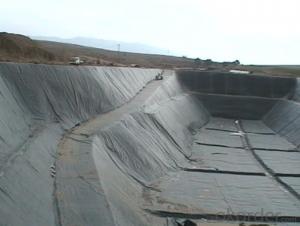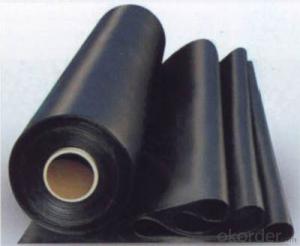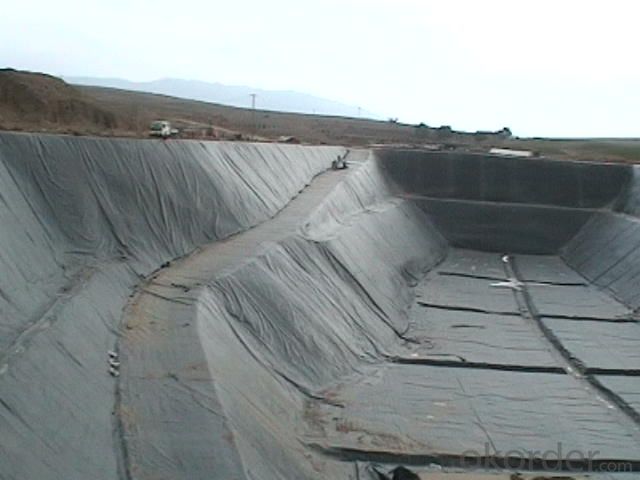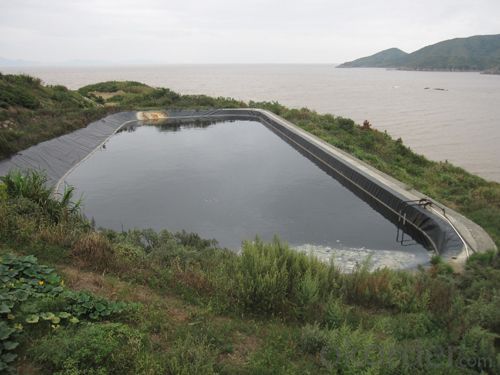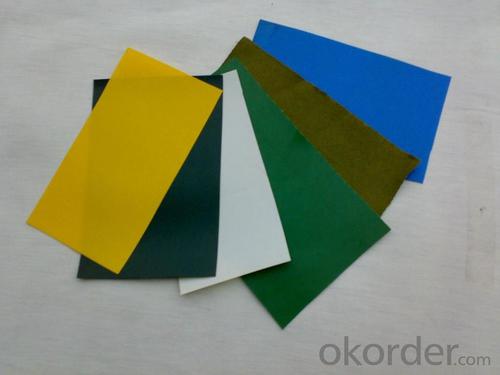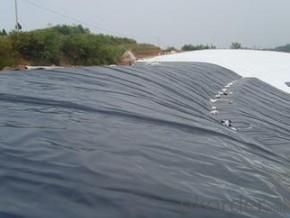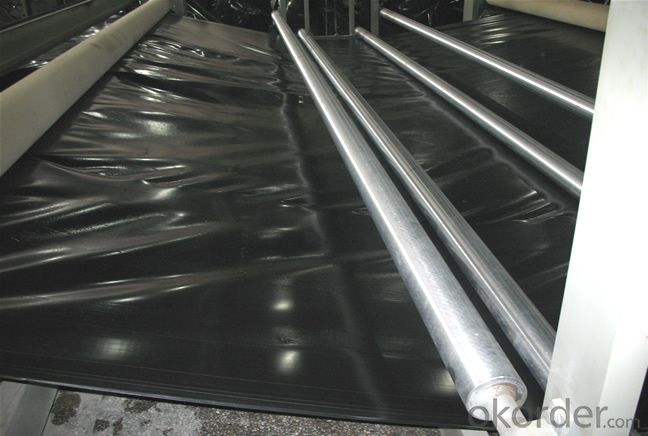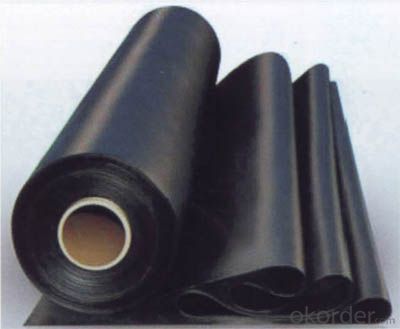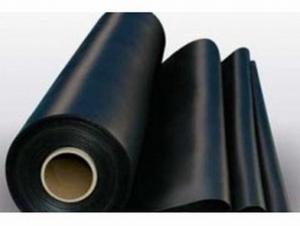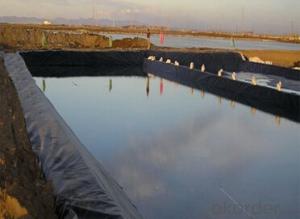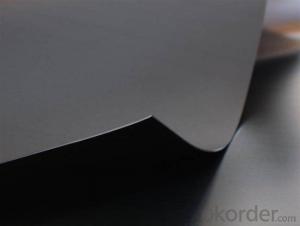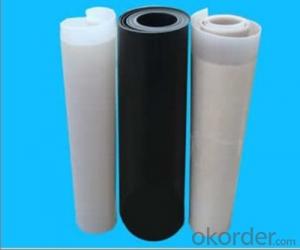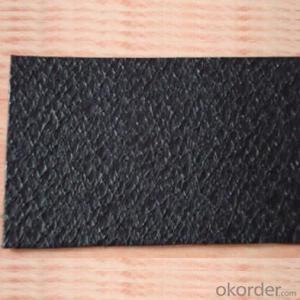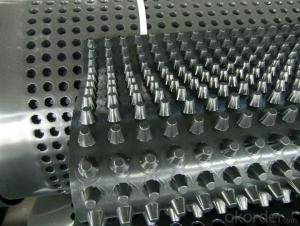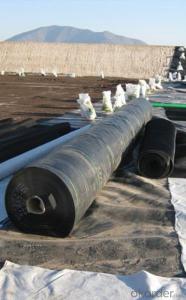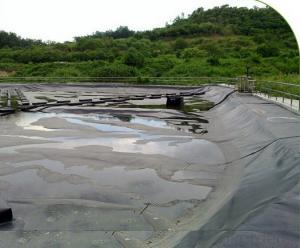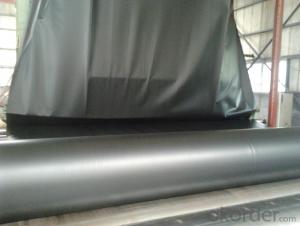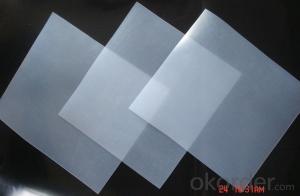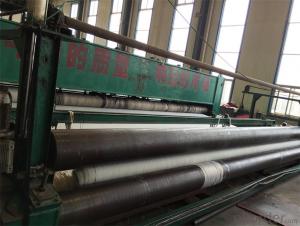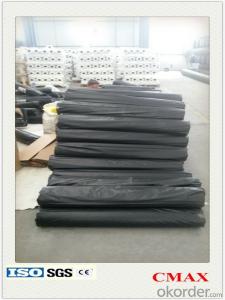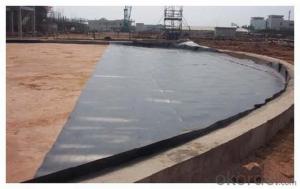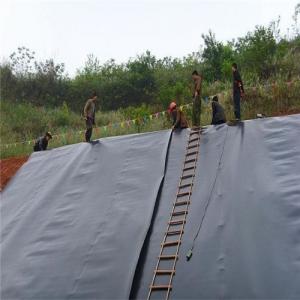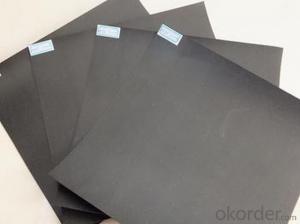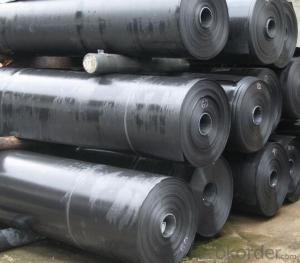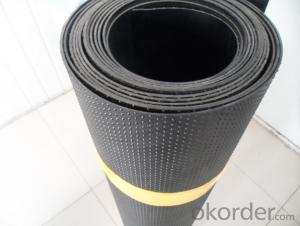Geomembrana Para Tanque - HDPE Geomembrane Black Plastic Sheeting for Pond
- Loading Port:
- Qingdao
- Payment Terms:
- TT or LC
- Min Order Qty:
- 10000 m²
- Supply Capability:
- 500000 m²/month
OKorder Service Pledge
OKorder Financial Service
You Might Also Like
Structure of HDPE Geomembrane Description
Geomembrane is a kind of waterproof material of high molecular polymer. It is mainly divided into LDPE geomembrane, HDPE geomembrane, PVC geomembrane and all kinds of composite geomembrane. HDPE geomembrane is made of high density polyethylene polymer by film-blowing process. It has smooth surface, textured surface as customers' requests.
Main Features of HDPE Geomembrane:
HDPE geomembrane is a kind of waterproof material of high molecular polymer. It is mainly divided into LDPE geomembrane, HDPE geomembrane, PVC geomembrane and all kinds of composite geomembrane.
1. Complete variety of specifications of width and thickness. Thickness: 0.2-3.0mm.
2. Excellent environmental stress resistant cracking performance.
3. Excellent performance of chemical erosion resistance.
4. Wide scope of application temperature and long service life
5. Low Permeability :HDPE lining systems are secure because leachate does not penetrate them, methane gas will not escape from the HDPE cover system , and rainwater will not infiltrate.
6.It is also suitable for sludge and secondary containment around chemical storage facilities.
7.Ultraviolet Resistance:HDPE geomembrane is resistant to UV exposure because of the addition of carbon black.
HDPE Geomembrane Images
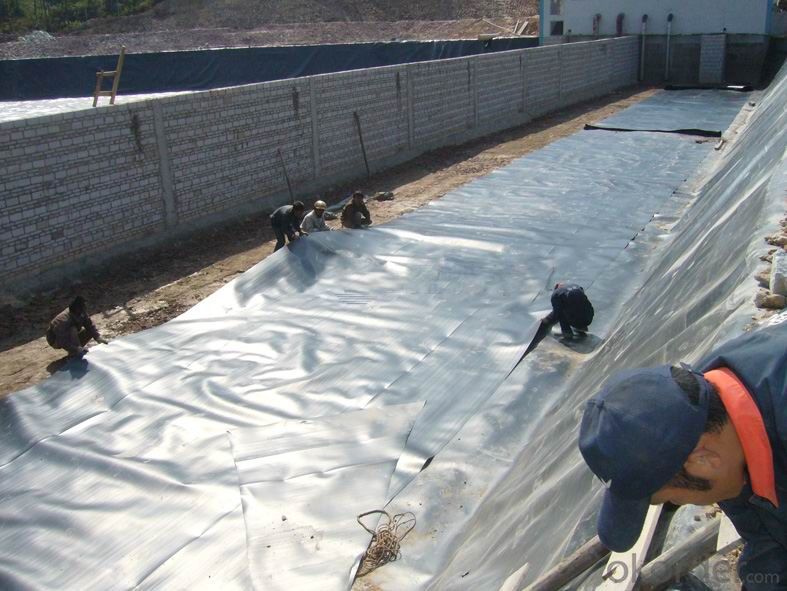
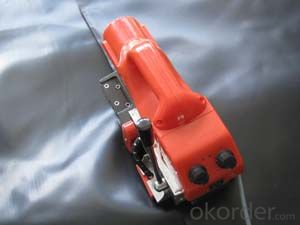
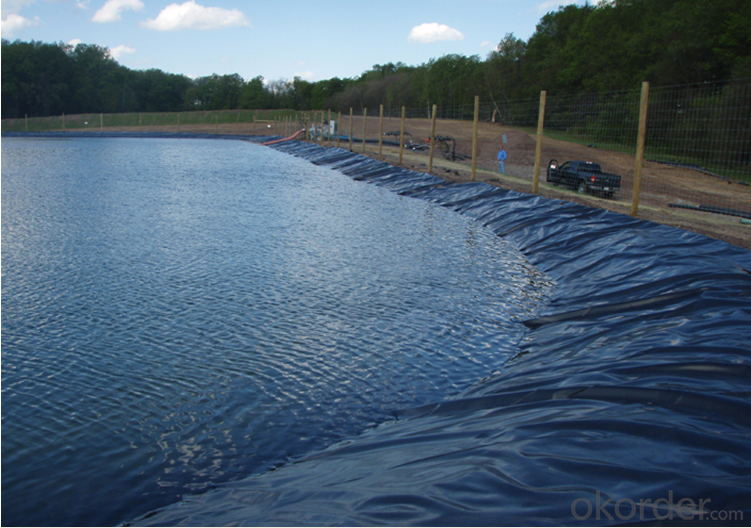
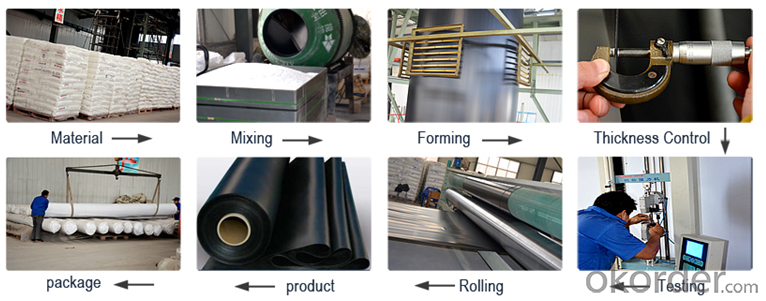
HDPE Geomembrane Specification :
1) Thickness : 0.2mm - 3.0mm.
2) Width : Within 8 m (1m-8m).
3) Length : 50-100m/roll (as request).
4) Material : HDPE,( LDPE, LLDPE, PVC, EVA ,CPE).
5) Color : Black , white , red , blue , or as required.
6) Anti - UV, anti - aging, high strength, anti-corrosion, high temperature-resistant, non-toxic.
7) We are free to provide professional engineering solutions for customers, and we send workers to construct for customers.
Item | Index | |
GH-1 | GH-2 | |
Tensile Strength (Mpa) | ≥17 | ≥25 |
Breaking elongation rate % | ≥450 | ≥550 |
Right Angle Breaking Strength (N/mm) | ≥80 | ≥110 |
Carbon Black Content (%) | ≥110 | |
Oxidation Induction Time at 200℃ | -- | ≥1500 |
Environmental Stress Cracking Resistance F20 (h) | -- | ≥20 |
Water Vaport Permeability Coefficient g.cm/(cm2.s.pa) | ≤1.0×10-16 | |
Embrittlement Performance at Low Temperature of -70℃ | Passed | |
Dimensional Stability (%) | ±3 | |
FAQ:
1. How about the delivery time?
Two weeks upon receipt of down payment.
2. What kind of payments do we accepted?
T/T, L/C, WesternUnion, MoneyGram.
3. What's are the MOQ?
Normally the MOQ is 5000 SQM in theory.
And we can provide you free samples for quality inspection.
4. Do you charge for the samples?
Accordeing to our company policy, the samples are freee, we only charge the freight fee. And we will return the freight fee in your second order.
5. Can you produce the product according to customers' requirements?
Sure, we are professional manufacturer, OEM and ODM are both welcome
- Q: What are the advantages of using geomembranes in waste containment systems?
- There are several advantages of using geomembranes in waste containment systems. Firstly, geomembranes act as a barrier, preventing the leakage of hazardous substances into the surrounding environment, thus protecting the soil, groundwater, and nearby ecosystems. Additionally, they offer excellent chemical resistance, ensuring the containment of various waste materials without degradation. Geomembranes also have a high tensile strength, making them durable and capable of withstanding mechanical stresses. Moreover, they are flexible and can conform to irregular surfaces, allowing for easy installation and reducing the need for excavation. Overall, the use of geomembranes in waste containment systems provides a reliable and cost-effective solution for managing and preventing environmental contamination.
- Q: What are the environmental impacts of geomembranes?
- Geomembranes, which are impermeable barriers used in various environmental applications, can have both positive and negative environmental impacts. On the positive side, geomembranes help prevent the migration of pollutants, such as hazardous chemicals, from contaminating soil, groundwater, and surface water. They also play a crucial role in preventing soil erosion and protecting sensitive ecosystems. However, it is important to consider the potential negative impacts as well. The production of geomembranes involves the use of natural resources and energy, which contribute to carbon emissions and other forms of pollution. Additionally, if not properly managed, geomembranes can become waste at the end of their lifespan, leading to disposal challenges and potential negative effects on ecosystems. To mitigate these impacts, it is crucial to adopt sustainable practices in the production, use, and disposal of geomembranes. This includes selecting materials with lower environmental footprints, implementing recycling and reuse programs, and ensuring proper installation and maintenance to maximize their lifespan.
- Q: Water pond impermeable or membrane geomembrane.
- geomembrane and impermeable membrane film called both with the same kinds of products like water ponds geomembrane HDPE (High Density Polyethylene) Material Material HDPE geomembrane seepage effect in addition to having good outside with higher puncture resistance, tear resistance, resistance to current standard of ability HDPE geomembrane two standard type that is standard (GB / T17643-2011 GH-I), marking the second type (GB / T17643-2011 GH-II) using standard like ordinary water pond HDPE geomembrane according to user type from the water depth with procurement thickness HDPE geomembrane.
- Q: Can geomembranes be used for geothermal energy storage?
- Yes, geomembranes can be used for geothermal energy storage. Geomembranes are impermeable materials that can effectively contain fluids, making them suitable for creating underground reservoirs to store geothermal energy. These membranes can help prevent the loss of heat and fluid, ensuring efficient and long-term storage of geothermal energy.
- Q: What are the considerations for geomembrane installations in areas with high temperature differentials?
- When installing geomembranes in areas with high temperature differentials, there are several important considerations to take into account. Firstly, the choice of geomembrane material is crucial. Opting for a material that can withstand extreme temperature variations is essential to ensure its longevity and effectiveness. Additionally, proper anchoring and fastening methods should be employed to secure the geomembrane in place and prevent any potential damage caused by thermal expansion or contraction. Adequate thermal insulation or reflective barriers may also be necessary to minimize the impact of temperature differentials on the geomembrane. Finally, regular inspections and maintenance should be carried out to identify and address any potential issues or damage that may arise due to the temperature differentials.
- Q: What is the hardness of HDPE board? What kind of knife is used to cut?
- DPE board (high density polyethylene sheet) melting point is about 130 ℃. It has good mechanical strength. It has good heat resistance and cold resistance, good environmental stress crack resistance. It is advised that the range of melting temperature is 200-250℃. The melting temperature is 220℃-260℃. The relative density is 0. For materials with larger molecules, 941-0, it has higher rigidity and toughness and good chemical stability. It can use carbide cutter tool or diamond cutter to cut. Dielectric properties. Hardness is about 30-45HRC.
- Q: What is national standard of geomembrane?
- Geomembrane national standards have not requirements for construction loss. Do you want to ask lapping? Normal lapping is 15-20CM.
- Q: How to use electrothermal?film?
- Clip must be used on one of the ends of the wire and then connect the wire, wrap with daub and black rubber in case of electric leakage, and on another end of the wire should be wrapped with professional daub and black rubber in case of electric leakage. It is about 200 watts per square meter.
- Q: How do geomembranes handle settlement?
- Geomembranes are designed to handle settlement by providing a flexible and impermeable barrier between the soil and surrounding environment. They are typically installed with a sufficient amount of slack to accommodate settlement without tearing or compromising their integrity. Additionally, geomembranes can be reinforced with geotextiles or other materials to enhance their resistance to settlement. When settlement occurs, the geomembranes are able to conform to the changing soil conditions while maintaining their intended function of preventing leakage or contamination.
- Q: Are geomembranes resistant to thermal expansion?
- Yes, geomembranes are typically resistant to thermal expansion. They are designed to withstand temperature variations without significant dimensional changes or deformation, making them suitable for applications where thermal expansion is a concern.
Send your message to us
Geomembrana Para Tanque - HDPE Geomembrane Black Plastic Sheeting for Pond
- Loading Port:
- Qingdao
- Payment Terms:
- TT or LC
- Min Order Qty:
- 10000 m²
- Supply Capability:
- 500000 m²/month
OKorder Service Pledge
OKorder Financial Service
Similar products
Hot products
Hot Searches
Related keywords
